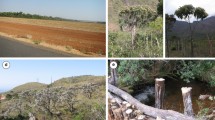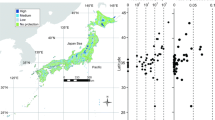Abstract
Protected areas are one of the main strategies of biodiversity conservation. However, if these areas do not coincide spatially with priority areas for conservation, they may not fully achieve their objective. Cactaceae is one of the most frequent plant families in the drylands of the neotropical region, but also one of the most threatened. Our objective was to understand whether the protected areas in the Brazilian semiarid region (Caatinga) include hotspots of the Cactaceae family. For this, we used distribution models of 81 species to calculate the corrected weighted endemism index (CWEI) and compared it with the size and location of 160 protected areas that currently exist in the region. Our results show that 4.7% of the area with the highest CWEI occur within protected areas, especially in those with fully protected status (the highest protection level according to Brazilian legislation, which is equivalent to IUCN categories I to III). However, 99.3% (75,758 km²) of the summed protected areas have a low or very low CWEI, and only 0.7% (532 km²) have a high or very high CWEI. These results suggest the importance of reassessing priority areas for in situ conservation of Cactaceae in the Caatinga region.





Similar content being viewed by others
Data Availability
and material.
The supplementary data is provided in electronic online resources accompanying the manuscript. Further details available in Figshare (https://doi.org/10.6084/m9.figshare.15175515).
Code Availability
The codes are available in Github (https://github.com/CarvalhoResearch/Protect_Endemism_Cacti.git).
References
Aiello-Lammens ME, Boria RA, Radosavljevic A, Vilela B, Anderson RP (2015) spThin: an R package for spatial thinning of species occurrence records for use in ecological niche models. Ecography 385 541–545. https://doi.org/10.1111/ecog.01132
Allouche O, Tsoar A, Kadmon R (2006) Assessing the accuracy of species distribution models: prevalence, kappa and the true skill statistic (TSS). J Appl Ecol 436:1223–1232. https://doi.org/10.1111/j.1365-2664.2006.01214.x
Alvares CA, Stape JL, Sentelhas PC, de Moraes Gonçalves JL, Sparovek G (2013) Köppen’s climate classification map for Brazil. Meteorol Z 711–728. https://doi.org/10.1127/0941-2948/2013/0507
Antongiovanni M, Venticinque EM, Fonseca CR (2018) Fragmentation patterns of the Caatinga drylands. Landsc Ecol 338:1353–1367. https://doi.org/10.1007/s10980-018-0672-6
Antongiovanni M, Venticinque EM, Matsumoto M, Fonseca CR (2020) Chronic anthropogenic disturbance on Caatinga dry forest fragments. J Appl Ecol 57(10):2064–2074. https://doi.org/10.1111/1365-2664.13686
Brasil(2000). LeiN°9.985,DE18DEJULHODE2000. https://www.planalto.gov.br/ccivil_03/leis/l9985.html
Brasil. Ministério do Meio Ambiente (2018). Portaria n.º 463, de 18 de dezembro de 2018. Diário Oficial da União. 19/12/2018, Edição: 243, Seção: 1, p. 160
Brasil. Ministério do Meio Ambiente (2020). Painel de Unidades de Conservação Brasileiras. Acessed in: https://app.powerbi.com/view?r=eyJrIjoiMDNmZTA5Y2ItNmFkMy00Njk2LWI4YjYtZDJlNzFkOGM5NWQ4IiwidCI6IjJiMjY2ZmE5LTNmOTMtNGJiMS05ODMwLTYzNDY3NTJmMDNlNCIsImMiOjF9, Acessed in 16 jul. 2020
Brasil. Ministério do Meio Ambiente (2021) 2ªAtualizaçãodasÁreasPrioritáriasparaConservaçãodaBiodiversidade2018.Disponívelem:http://areasprioritarias.mma.gov.br/2-atualizacao-das-areas-prioritarias, Acessed in 16 jul. 2021
Butchart SHM, Scharlemann JPW, Evans MI, Quader S, Aricò S, Arinaitwe J, Balman M, Bennun LA, Bertzky B, Besançon C, Boucher TM, Brooks TM, Burfield IJ, Burgess ND, Chan S, Clay RP, Crosby MJ, Davidson NC, Silva ND, Woodley S (2012) Protecting Important Sites for Biodiversity Contributes to Meeting Global Conservation Targets. PLOS ONE . 73-e32529. https://doi.org/10.1371/journal.pone.0032529
Carvalho G (2021) flora: Tools for Interacting with the Brazilian Flora 2020.https://CRAN.R-project.org/package=flora
Convention on Biological Diversity (2010) COP Decision.https://www.cbd.int/decision/cop/?id=12268
Correa-Cano ME, Goettsch B, Dufy JP, Bennie J, Inger R, Gaston KJ (2018) Erosion of natural darkness in the geographic ranges of cacti. Sci Rep 8:4347. DOI:https://doi.org/10.1038/s41598-018-22725-8
Crisp MD, Laffan S, Linder HP, Monro A (2001) Endemism in the Australian flora. J Biogeogr 28:2183–198. https://doi.org/10.1046/j.1365-2699.2001.00524.x
Dony JG, Denholm I (1985)Some Quantitative Methods of Assessing the Conservation
Value of Ecologically Similar Sites. J Appl Ecol 22:229–238. https://doi.org/10.2307/2403340
Drummond JA, Franco JLA, Ninis AB (2009) Brazilian federal conservation units: a historical overview of their creation and of their current status. Environ Hist 15:463–491. https://doi.org/10.3197/096734009X12532652872036
DRYFLOR (2016) Plant diversity patterns in neotropical dry forests and their conservation implications. Science, 353:1383–1387. https://doi.org/10.1126/science.aaf5080
Dudley N (2008) Guidelines for Applying Protected Area Management Categories. IUCN
Fernandes MF, Cardoso D, de Queiroz LP (2020) An updated plant checklist of the Brazilian Caatinga seasonally dry forests and woodlands reveals high species richness and endemism. J. Arid Environ 174:104079. https://doi.org/10.1016/j.jaridenv.2019.104079
Gariglio MA, Sampaio EDS, Cestaro LA, Kageyama PY (2010) Uso Sustentável e Conservação dos Recursos Florestais da Caatinga. http://www.florestal.gov.br/publicacoes/563-uso-sustentavel-e-conservacao-dos-recursos-florestais-da-caatinga
Gibson AC, Nobel PS (1966) The Cactus Primer. Harvard University Press.https://www.degruyter.com/document/doi/10.4159/harvard.9780674281714/html
Goettsch B, Hilton-Taylor C, Cruz-Piñón G, Duffy JP, Frances A, Hernández HM, Inger R, Pollock C, Schipper J, Superina M, Taylor NP, Tognelli M, Abba AM, Arias S, Arreola-Nava HJ, Baker MA, Bárcenas RT, Barrios D, Braun P, Gaston KJ (2015) High proportion of cactus species threatened with extinction. Nature Plants 110:1–7. https://doi.org/10.1038/nplants.2015.142
Hengl T, de Jesus JM, Heuvelink GBM, Gonzalez MR, Kilibarda M, Blagotić A, Shangguan W, Wright MN, Geng X, Bauer-Marschallinger B, Guevara MA, Vargas R, MacMillan RA, Batjes NH, Leenaars JGB, Ribeiro E, Wheeler I, Mantel S, Kempen B (2017) SoilGrids250m: Global gridded soil information based on machine learning. PLOS ONE 122:e0169748. https://doi.org/10.1371/journal.pone.0169748
Hunt D, Taylor N, Charles G (2006) The new cactus lexicon: descriptions and illustrations of the cactus family. DH Books, p 373
IBGE (2019) BiomaseSistemaCosteiro-Marinho do Brasil. https://www.ibge.gov.br/apps/biomas/
IUCN(2021). The IUCN Red List of Threatened Species. IUCN Red List of Threatened Species. https://www.iucnredlist.org/en
Karger DN, Conrad O, Böhner J, Kawohl T, Kreft H, Soria-Auza RW, Zimmermann NE, Linder HP, Kessler M (2017) Climatologies at high resolution for the earth’s land surface areas. Sci. Data 41:170122. https://doi.org/10.1038/sdata.2017.122
Landis JR, Koch GG (1977) The Measurement of Observer Agreement for Categorical Data. Biometrics 331:159–174. https://doi.org/10.2307/2529310
Leroy B, Meynard CN, Bellard C, Courchamp F (2016) virtualspecies, an R package to generate virtual species distributions. Ecography 396:599–607. https://doi.org/10.1111/ecog.01388
Machado MCetal (2013) Cactaceae. In: Martinelli G, Moraes MA (eds) Livro vermelho da flora do Brasil, 1 edn. Instituto de Pesquisas Jardim Botânico do Rio de Janeiro, Rio de Janeiro, pp 60–78
Martinelli Getal (2013) Avaliações de risco de extinção de espécies da flora brasileira. In: Martinelli G, Moraes MA (eds) Livro vermelho da flora do Brasil, 1 edn. Instituto de Pesquisas Jardim Botânico do Rio de Janeiro, Rio de Janeiro, pp 60–78
Menezes MOT, Ribeiro-Silva S (2015) Cactáceas do Ceará, Brasil: Prioridades para a Conservação. Gaia Sci 2:9:67–76
Nobel PS, Hartsock TL (1983) Relationships between Photosynthetically Active Radiation, Nocturnal Acid Accumulation, and CO2 Uptake for a Crassulacean Acid Metabolism Plant, Opuntia ficus-indica. Plant Physiol 71(1):71–75.https://www.ncbi.nlm.nih.gov/pmc/articles/PMC1065988/
Overbeck GE, Vélez-Martin E, Scarano FR, Lewinsohn TM, Fonseca CR, Meyer ST, Müller SC, Ceotto P, Dadalt L, Durigan G, Ganade G, Gossner MM, Guadagnin DL, Lorenzen K, Jacobi CM, Weisser WW, Pillar VD (2015) Conservation in Brazil needs to include non-forest ecosystems. Divers Distrib 2112:1455–1460. https://doi.org/10.1111/ddi.12380
Phillips SJ, Anderson RP, Dudík M, Schapire RE, Blair ME (2017) Opening the black box: an open-source release of Maxent. Ecography 407:887–893. https://doi.org/10.1111/ecog.03049
Pimm SL, Jenkins CN, Abell R, et al (2014) The biodiversity of species and their rates of extinction, distribution, and protection. Science 344:1246752. https://doi.org/10.1126/science.1246752
Prado D (2003). As caatingas da Am?rica do Sul. In Ecologia e conserva??o da caatinga (p. 3–73).
Rodrigues ASL, Andelman SJ, Bakarr MI, Boitani L, Brooks TM, Cowling RM, Fishpool LDC, da Fonseca GAB, Gaston KJ, Hoffmann M, Long JS, Marquet PA, Pilgrim JD, Pressey RL, Schipper J, Sechrest W, Stuart SN, Underhill LG, Waller RW, Yan X (2004) Effectiveness of the global protected area network in representing species diversity. Nature 4286983:640–643. https://doi.org/10.1038/nature02422
Sampaio EVSB (1995) Overview of the Brazilian caatinga. In: Medina E, Mooney HA, Bullock SH (eds) Seasonally Dry Tropical Forests. Cambridge University Press, pp 35–63. https://doi.org/10.1017/CBO9780511753398.003
Scott JM, Davis FW, McGhie RG, Wright RG, Groves C, Estes J (2001) Nature Reserves: Do They Capture the Full Range of America’s Biological Diversity? Ecol Appl 114:999–1007. https://doi.org/10.1890/1051-0761(2001)011[0999:NRDTCT]2.0.CO;2
Silva AC, Souza AF (2018) Aridity drives plant biogeographical sub regions in the Caatinga, the largest tropical dry forest and woodland block in South America. 13:e0196130. https://doi.org/10.1371/journal.pone.0196130. PLoS ONE4
Silva SR, Zappi D, Taylor N, Marlon Machado (2011). Série Espécies Ameaçadas n.º 24. Instituto Chico Mendes de Conservação da Biodiversidade, Brasília, p 111. Plano de ação nacional para a conservação das Cactáceas
Simões SS, Zappi D, Costa GO, Aona LYS (2021) Distribution and conservation of Cactaceae in Brazilian Seasonally Dry Tropical Forests: insights from floristic and phytosociological surveys. Revista peruana de biología 28(1):e19745. https://doi.org/10.15381/rpb.v28i1.19745
Simões SS, Zappi D, Costa GO, Aona LYS (2019) Spatial niche modelling of five endemic cacti from the Brazilian Caatinga: Past, present and future. Austral Ecol 45(1):1–13. https://doi.org/10.1111/aec.12825
Taylor NP (2012) Cactiandtheirhabitats.Incactaceae systematic initiatives(Vol.28,p.5–15)
Taylor N, Zappi D (2004) Cacti of Eastern Brazil,Royal Botanical Gardens,Kew,499p
Taylor,N.&Zappi,D.(2018).Additions and corrections to ‘Cacti of Eastern Brazil’.Bradleya,2018(36),2–21. https://doi.org/10.25223/brad.n36.2018.a2
UNEP-WCMC & IUCN(2022),Protected Planet: The World Database on Protected Areas (WDPA) and World Database on Other Effective Area-based Conservation Measures (WD-OECM) [Online], January 2022, Cambridge, UK:UNEP-WCMC and IUCN. Available at:www.protectedplanet.net.
Velazco, S. J. E., Galvão, F., Villalobos, F., & Júnior, P. D. M. (2017). Using worldwide edaphic data to model plant species niches: An assessment at a continental extent. PLOS ONE 12(1):e0186025. https://doi.org/10.1371/journal.pone.0186025
Watson, J. E. M., Dudley, N., Segan, D. B. & Hockings, M. (2014). The performance and potential of protected areas. Nature 515(7525):67–73. https://doi.org/10.1038/nature13947
Werneck, F. P., Costa, G. C., Colli, G. R., Prado, D. E., Sites Jr, J. W. (2011). Revisiting the historical distribution of Seasonally Dry Tropical Forests: new insights based on palaeodistribution modeling and palynological evidencegeb. Glob Ecol Biogeogr 20:272–288. https://doi.org/10.1111/j.1466-8238.2010.00596.x
Zappi, D., Taylor, N. P. (2011) Status de Conservação. In: Silva, S. R., Zappi, D., Taylor, N. & Marlon Machado (Eds.) Plano de ação nacional para a conservação das Cactáceas. Série Espécies Ameaçadas n.º 24, Brasília: Instituto Chico Mendes de Conservação da Biodiversidade, p. 57–63.
Zappi D, Taylor NP (2020) Cactaceae. In: FloradoBrasil 2020. JardimBotânicodo Riode Janeiro. http://floradobrasil.jbrj.gov.br/reflora/floradobrasil/FB70.Acessed in:12 jul. 2021
Funding
This study was financed in part by the Coordenação de Aperfeiçoamento de Pessoal de Nível Superior - Brasil (CAPES) - Finance Code 001; The Fundação Cearense de Apoio Científico e Tecnológico (FUNCAP) provided a master’s scholarship to C. E. Carvalho. Furthemore, the National Institute of Science and Technology in Interdisciplinary and Transdisciplinary Studies in Ecology and Evolution (INCT IN-TREE) and the Brazilian Council for Scientific and Technological Development (CNPq) granted a scholarship to F. S. Araújo.
Author information
Authors and Affiliations
Contributions
C. E. Carvalho, J. C. Sfair designed the study. C. E. Carvalho obtained the models and the computational framework and analyzed the data. J. C. Sfair, F. S. Araújo and M. T. O Menezes supervised the analyzes and contributed to the interpretation of the results. All authors contributed to the writing of the manuscript.
Corresponding author
Ethics declarations
Conflicts of interest/Competing interests
The authors declare that there are no conflicts of interest.
Ethics approval
Not applicable.
Consent to participate
Not applicable.
Consent for publication
Not applicable.
Additional information
Communicated by Daniel Sanchez Mata.
Publisher’s Note
Springer Nature remains neutral with regard to jurisdictional claims in published maps and institutional affiliations.
Rights and permissions
About this article
Cite this article
Carvalho¹, C.E., Menezes, M.O.T., Araújo, F.S. et al. High endemism of cacti remains unprotected in the Caatinga. Biodivers Conserv 31, 1217–1228 (2022). https://doi.org/10.1007/s10531-022-02384-y
Received:
Revised:
Accepted:
Published:
Issue Date:
DOI: https://doi.org/10.1007/s10531-022-02384-y




